by W.S. Cranshaw * (1/17)
Quick Facts…
- Most ants that are found in homes nest outdoors and enter homes only to search for food or water.
- Almost all ants are workers, wingless females that search for food and maintain the colony.
- A small proportion of an ant colony are winged reproductive forms. These emerge periodically in swarms and fly away on mating flights.
- Removing sources of food and water will reduce visitation of ants and help to more effectively use baits for ant control.
- Slow-acting insecticides in baits allow them to be taken back to colonies and are most effective for eliminating ants.
Almost anywhere in the state one travels, ants will be the most common insects that can be found in yards, gardens, fields and forests. Tremendous numbers of ants normally reside in a typical house lot, although most lead unobserved lives underground or otherwise out of sight. Often it is only when they occur indoors or produce their periodic mating swarms that they come to human attention.
Overall, the activities of ants are quite beneficial. Many feed on other insects, including pest insects. Ant scavenging helps to recycle organic matter and their tunneling is useful in aerating and mixing soils. On the other hand, ants sometimes promote the activities of certain plant pests, notably aphids, that excrete sweet sugary honeydew that is favored by many ants.
Ants most prominently become problems when they are found in homes. Most ants found indoors in Colorado are merely foragers, seeking food or water in a home but returning to colonies they have established outdoors. A small number of the ants found indoors may become more permanent residents and establish a nest within a building. This ability to nest indoors is most often associated with pharoah ants; some colonies of pavement ants and carpenter ants may establish within a building.
Life History and Habits
Ants are social insects that live in a colony, usually consisting of thousands to tens of thousands of individuals. Within the colony are various ant “castes” of different forms and function. Colonies are overwhelmingly comprised of workers, wingless females that forage for food, construct, maintain and defend the nest, tend the young and do other necessary colony duties. Many kinds of ants produce workers that are all the same size (monomorphic); some, such as field ants, have workers that vary in size (polymorphic).
Each colony contains one or, sometimes, a few queens (Figure 1). These are fertile females that are larger than workers and dedicated to egg production. The minute eggs are taken from the queen and tended by the workers. Upon egg hatch, the pale-colored, legless larvae are fed and protected by the workers. When full-grown, ant larvae produce a smooth silken cocoon within which they pupate, ultimately emerging as an adult ant. Ant pupae are often seen when turning over a rock that exposes a colony and are sometimes mistakenly called “ant eggs”.
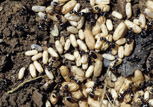 |
|
Figure 1: Ant pupae attending cocoons. Tending workers.
|
As colonies mature, winged forms of ants are also produced. These include females that are potential queens and slightly smaller males. These reproductives periodically leave the colony during swarming events, when they fly away en masse and attempt to mate. Such swarms usually occur during a sunny, calm period a few days
following a heavy rainfall.
The swarms of winged ants being pushed out of the colony often attract attention and alarm, particularly when they emerge in a garage or other building. However, these ants never return to the colony after they have left on a mating flight. After they disperse, time the ants mate and the now fertilized females attempt to establish a new colony. The males die within a couple of days of leaving the colony following the swarming event.
Winged ants are sometimes mistaken for winged termites. However, ants can be easily distinguished by having a narrow constriction between the thorax and abdomen (“wasp waist”), antennae that are elbowed, and hindwings that are smaller than the forewings (Figures 5).
Most new ant colonies are developed by a queen following a mating flight. After being fertilized, she moves under a rock or some other crevice and sheds her wings. She then attempts to establish a new colony, largely living off the energy of her now unneeded flight muscles. Only a tiny fraction of the females are successful in their efforts and most perish without a new colony developing. If they are successful, the colonies will slowly grow, becoming full sized after several years.
Some kinds of ants can establish new colonies by producing multiple queens within a colony and then dividing (“budding”). This habit is particularly common with pharoah ants that may split colonies and scatter in response to disturbances, including use of some insecticides. Other types of ants, such as carpenter ants, may form “satellite colonies” that contain large numbers of foraging workers but lack a queen or developing young.
Worker ants forage constantly during the warmer months of the year. The workers lay down chemical trails as they forage that helps direct other workers to sources of food or water. Feeding habits of the various kinds of ants vary with sugary materials preferred by most species, at least for part of their diet. Others may favor greasy materials, seeds, or protein-rich foods such as living or dead insects. Feeding habits may shift during the season with changes in colony needs.
Ants Commonly Found in Colorado Homes
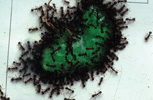 |
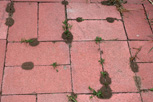 |
|---|---|
|
Figure 2: Pavement ants visiting mint apple jelly.
|
Figure 3: Soil piled at nest entrance, typical of pavement ant.
|
Pavement ants (Tetramorium caespitum) are ants to have first found their way to Colorado only in the past few decades but now are often the most common species that people notice (Figure 2). They characteristically produce small mounds of soil at entrances of their nest, and nests are often located under pavement or rocks (Figure 3). They are small ants (1/10-1/16-inch), dark-brown colored and have fine grooves that line their head. Pavement ants forage a wide variety of foods, usually consistently preferring greasy materials. Feeding habits shift during the season with higher protein materials being sought when young are being reared and sugars more favored at other times.
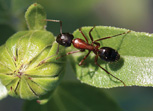 |
|---|
|
Figure 4: Field ants (Formica species)
|
Field ants (Formica species) are among the most common ants found in yards and gardens and are observed in homes most commonly in spring (Figure 4). They are black or reddish-brown and black ants of medium size (3/16-1/3 inch) and sometimes are mistaken for carpenter ants. They nest outdoors in loose soil and some produce mounds that incorporate twigs, dried leaves and other plant materials. Migrations into homes occur in spring when soils warm enough to cause colonies to resume activity but cool temperatures prevent normal foraging in yards. Field ants feed on a variety of foods but most often are observed visiting sweet honeydew excreted by aphids and or other sweet materials.
 and queen (bottom) of a carpenter an SL WEB.jpg) |
|
Figure 5: Winged adult male (top) and queen (bottom) carpenter ants.
|
Carpenter ants (Camponotus species) are the largest ants that occur in Colorado (1/4-3/8 inch) and are particularly abundant in forested areas. They may be either black or black with a reddish brown thorax. They are most similar to the field ants but can be distinguished by examining them in side view, with the thorax of the carpenter ants being uniformly rounded without indentation. Carpenter ants nest in wood, almost always establishing colonies in wood almost always are foragers that will return to an outdoor nest in the yard. Rarely they will establish a nest in the building, always at some point of previous water-damage. Carpenter ants (Figure 5) mostly feed on a mixture of dead insects and honeydew.
Cornfield ants (Lasius species) are relatively small ants (less than 1/8 inch) that are usually light to medium-brown colored. They nest outdoors but sometimes will enter buildings to feed on sweet materials.
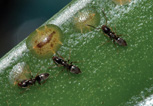 |
|
Figure 6: Odorous house ants. Photo courtesy of Susan Ellis.
|
Odorous house ants (Tapinoma sessile) are small (1/10-inch) black ants that have only recently been found in Colorado (Figure 6). When disturbed, they will raise their abdomen and emit an odor reminiscent of coconut. They do not nest indoors but may enter to forage on various foods including sweets, cooked vegetables, fruit slices and pastries. Heavy mulch adjacent to building foundations has been associated with increased problems with odorous house ants.
Pharoah ants (Monomorium pharoaensis) are minute (1/12 inch), light-brown ants that are adapted to nesting in buildings. Nests can spread extensively through a structure as pharoah ants may frequently move nest locations, produce multiple queens, and may split to form “satellite” colonies. Pharoah ants feed on a wide range of foods that include syrups, jellies, grease, cake, and pet foods. They can be serious pests of hospitals, dormitories and apartments.
Management of Household Ants
 |
|
Figure 7: Insecticide applied as a gel bait
|
The first and most important step to reducing problems with ants occurring in homes is to eliminate sources of food and water that are attractive. In addition to obvious sources of food left on counters, sinks or floors, spilled food in cupboards and food associated with trash baskets may also be visited by foraging ants. Dripping faucets and leaking pipes may also be important water sources that ants will use. Also, if ants have been foraging in a home, wash down counters or floors with some household cleaner to eliminate the odor trails the ants have established to locate sources of food or water.
Most ants found in homes nest outdoors, sometimes adjacent to building foundations. Heavy mulch, piled leaves or ground covers that abut buildings can provide cover for ant colonies and can increase the likelihood of their subsequent occurrence in a house. Keeping the area around the building foundation free of cover can reduce the likelihood of ants foraging indoors.
Insecticides can be useful to control ants and a wide range of ant control products are available. These are primarily used either to: 1) generally suppress ant numbers in a yard; 2) establish perimeter barriers around a home; 3) spot treat foraging ants found in homes; or 4) incorporate into baits to kill colonies.
General Suppression of Ants in Yards. Products used for general ant suppression include various sprays, dusts or granules applied to lawns (Table 1). These surface-applied treatments can temporarily reduce numbers of ants foraging through lawns and on garden beds. However, such treatments do not penetrate into colonies nor do they affect ants that use below-ground tunnels for much of their travel.
Similarly, applications of such insecticides made directly to nests will often kill only surface foragers, again providing only temporary control. The great majority of the ants within the nest will not be affected unless insecticides thoroughly penetrate into the colony, which may extend a few feet deep. Where entrance areas are disturbed by insecticides or other activities, colonies will often abandon the treated area and establish new entrances at a different location.
Alternatives to insecticides are sometimes sought. Boiling water can kill small colonies that do not extend too deeply. Large colonies spread over a wide area, those that extend deeply into the ground, and those that are in sites cannot be managed by this method. Furthermore, the hazards of handling boiling water generally exceed that of using currently available ant insecticides, with less likelihood of success.
Perimeter Treatments of Buildings. Most ants that occur within homes originate from outdoor colonies. An insecticide barrier maintained around the building perimeter can inhibit much of this activity. Such treatments are generally applied as sprays or dusts to the soil immediately adjacent to the building and/or the lower areas of walls. Particular attention should be given to areas where ants are known to be able to enter buildings, such as near foundation cracks or windows. However, such treatments will not be able to well control ants that enter homes through below ground openings in building foundations.
Essentially, all such perimeter treatments involve insecticides of the pyrethroid class (beta-cyfluthrin, bifenthrin, deltamethrin, lambda-cyhalothrin, permethrin) and these typically may persist to control ants for a week to around month under outdoor conditions. One perimeter treatment with a different mode of action is hydramethylnon, an insect growth regulator. Sold in a granule formulation under the Amdro trade name, it acts as a bait that may be accepted by some species of ants that occur in Colorado homes. Baits are discussed below.
Household spot sprays. Some household insecticides allow use indoors as a surface spray to kill ants that move across treated surfaces. Such treatments are best applied to cracks and crevices used by foraging ants to enter living areas. However, these have very limited and short-term effectiveness as the insecticides degrade and/or the ants change routes of activity. Far more effective are insecticides used as baits, fed on by ants and returned to the nest. Contact
sprays should not be used in the vicinity where baits are applied.
Baiting. Use of ant baits will usually provide the most satisfactory control. This strategy involves use of acceptable food into which a small amount of an insecticide is incorporated. The ants feed on the bait and return it to the colony where it is shared with nest mates (trophyllaxis).
The types of insecticides used for baiting ants (Table 1) are very different than those used as sprays around building perimeters or in spot treatments. Instead of being fast acting, these have slower effects that allow the forager ant time to carry the treated food back to the nest. Boric acid, borax and arsenic trioxide are some of the older insecticides used as baits. Others act as insect growth regulators (e.g., hydramethylnon), affecting insect hormones that affect growth or prevent queens from producing fertile eggs. In recent years, several new insecticides have been marketed that have different activity allowing highly effective disruption of ant colony functions (e.g., fipronil, dinotefuran, indoxacarb).
The formulation of insecticides used as ant baits is also different. Historically, baits involved solid food mixtures placed inside a bait station (“ant trap”) that was visited by ants. In recent years food baits that are applied as gel droplets or are in bait stations that provide liquids have been marketed. Solid food-based baits are also available now in a broadcast form for use outside.
Several features determine if ants can be successfully controlled with baits (Table 2). Perhaps most important is that the bait is acceptable to the ant so that they will feed on it. Feeding habits of the various ants found in homes vary with some preferring sweet materials (e.g., field ants, cornfield ants), others favoring greasy materials (e.g., pavement ants). Another important factor in bait acceptance is moisture content. Baits often become unattractive when they dry out, a common problem in the arid climate of Colorado. For this reason, liquid and gel formulated baits may often be more readily accepted by ants. Carpenter ants are one group of ants that will not visit most solid ant baits but will feed at some liquid or gel sugar-based baits.
| Table 1. Insecticides Used for Control of Ants (listed by active ingredients) | |
|
Insecticides Used as Sprays, Dusts or Granules for |
|
| beta-cyfluthrin | bifenthrin |
| carbaryl | deltamethrin |
| lambda-cyhalothrin | lambda-cyhalothrin |
|
Insecticides Used as Baits
|
|
| abamectin/avermectins | boric acid/Orthoboric acid/Borax |
| dinotefuran | fipronil |
| hydramethylnon | inoxcarb |
| Table 2. Steps to take for effectively using ant baits |
| Clean up areas of the home to deny ants alternate sources of food. |
| Fix water leaks and other sources of moisture. |
| Avoid using other insecticides that might deter ants visiting the baits. |
| Choose an ant bait that is acceptable to the type of ant found in your home. |
| Place the bait in an area that is visited by ants. |
| Replace ant baits if they dry out or are consumed. |
Effectively using baits also requires a few steps be taken so that the ants will visit and feed upon the baits. Most important is to deny them alternate food and water sources within the home. Thoroughly clean-up food preparation areas and other sites of ant activity. Secure garbage cans to prevent ant foraging. Leaking faucets
and other areas providing free water should also be corrected.
Spot sprays of insecticides should not be used in the vicinity of a bait station. The point of effective ant baiting is to get ants to actively visit the bait. Place the baits in areas where ant activity has been observed. Ant baits will need to be reapplied if they dry out or are consumed.
Effects of ant baiting usually start to become apparent within a week or two after they are begun. Under optimum conditions the ant colony may ultimately be eliminated by a bait program.
Homemade ant baits are sometimes prepared. These involve incorporating a small percentage (ca 5-10% by weight) of boric acid or borax with some acceptable food. Since feeding preferences of ants vary, test several foods to see if they are visited. Among the commonly available foods accepted by ants are either sweet materials, such as honey or apple jelly, and/or greasy, protein rich materials, such as peanut butter. If these baits are made, they must be applied in a manner so that pets or children can not reach them. Placement of the bait in a sealed container with punched entry holes can produce a more protected bait station. Baits containing boric acid/borax also cannot be applied directly to soils where plants are growing as boron-containing materials can be soil sterilants.
*Colorado State University Extension entomologist and professor, bioagricultural sciences and pest management. 11/96. Revised 1/17.
Colorado State University, U.S. Department of Agriculture and Colorado counties cooperating.
Extension programs are available to all without discrimination. No endorsement of products mentioned is intended nor is criticism implied of products not mentioned.
Go to top of this page.





